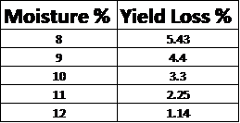AGRONOMIC RESOURCESTO SUPPORT EVERY SEASON
YOU CAN TAKETO THE FIELD
How Soybean Moisture at Harvest Impacts Yield
In my area of Northern Indiana, and many other parts of the Midwest, a lot of soybeans were planted early and before most corn. Probably more than I’ve ever seen in my 52 years. It’s late August and I’ve already seen beans starting to get that yellowish tint that indicates harvest is just around the corner. With the possibility of an earlier than normal soybean harvest, that might mean that we’re harvesting in hotter conditions than what is typical.
 So, why does that matter? Harvest moisture can have a big impact on how many bushels you’re putting in the bin. To the left is a summary of a study done by the University of Nebraska. With the high-yielding soybean genetics available today, you can see how quickly those losses can add up! For simple math, say you have 100 Bu/A beans and 4% loss due to dry moisture. That’s 4 bushels of yield loss, at $9 beans, for a $36 per acre loss! That’s a lot my friends!
So, why does that matter? Harvest moisture can have a big impact on how many bushels you’re putting in the bin. To the left is a summary of a study done by the University of Nebraska. With the high-yielding soybean genetics available today, you can see how quickly those losses can add up! For simple math, say you have 100 Bu/A beans and 4% loss due to dry moisture. That’s 4 bushels of yield loss, at $9 beans, for a $36 per acre loss! That’s a lot my friends!
How to Manage Soybean Moisture During an Early Harvest
Here are a few considerations on how to manage an early harvest. Optimum harvest moisture is 13-15%. Start checking fields while there are still a few leaves still hanging on to the plant. It’s okay to harvest at 16-18% moisture if you can run some air through the soybeans once they're in the bin.
If you have hot daytime temperatures in your area, the soybeans will lose moisture throughout the day. Keep an eye on that monitor. It’s hard to do with a bunch of acres to harvest, but it might pay in the long run to stop during the heat of the day. Shatter loss also becomes a much bigger issue during this dry heat. Beans will add moisture on cool nights with a dew.
Fungicide During Harvest
Did you spray fungicide this year? That's another thing to consider when it comes to harvest time. Sometimes, spraying fungicide makes beans hang on to moisture a while longer. It can also cause a bit more of a green stem issue at harvest, too. Slow down a little to let the combine do it’s thing with less crushing of the beans.
As we head into seed plans for next year, keep in mind how the industry has adjusted to plant beans earlier and harvest earlier. Spread out your maturities and planting plans so all your beans don’t reach maturity at the same time.
Reach out to any of your LG Seeds team members with any questions, help evaluating the moisture of your soybeans, or with help to make a field-by-field plan for next year. Happy harvest! #WeMeanBusiness






Technical Team Agronomist